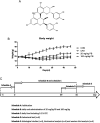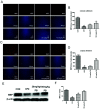Procyanidin B2 mitigates behavioral impairment and protects myelin integrity in cuprizone-induced schizophrenia in mice
- PMID: 35540280
- PMCID: PMC9081829
- DOI: 10.1039/c8ra03854f
Procyanidin B2 mitigates behavioral impairment and protects myelin integrity in cuprizone-induced schizophrenia in mice
Abstract
Numerous studies have suggested that neuropathological changes in schizophrenia may be related to damage to white matter or demyelination. Procyanidin B2, which is a constituent of many fruits such as grapes and strawberries, has various biological activities such as anti-inflammatory and anti-tumor activity, as has been reported. This study aimed to estimate the effects of procyanidin B2 on behavioral impairment and the protection of myelin integrity in a cuprizone-induced schizophrenia model. Mice were exposed to cuprizone (0.2% w/w in chow) for five weeks to induce schizophrenia-like behavioral changes and demyelination. Procyanidin B2 (20 or 100 mg kg-1 day-1) or vehicle was administered orally to mice after withdrawal from cuprizone. Behavioral impairment was detected with an open-field test, a rotarod test and a Morris water maze. Myelin integrity was assessed using LFB staining and MBP expression, including immunofluorescence and western blotting. In addition, enhancements in the expression of HO-1 and NQO1 suggested that procyanidin B2 may regulate oxidative homeostasis via promoting the translation of Nrf2 to the nucleus. Data indicated that procyanidin B2 could mitigate behavioral impairment and protect myelin integrity in the cuprizone-induced model via regulating oxidative stress by activating Nrf2 signaling.
This journal is © The Royal Society of Chemistry.
Conflict of interest statement
There are no conflicts to declare.
Figures







Similar articles
-
Clemastine rescues behavioral changes and enhances remyelination in the cuprizone mouse model of demyelination.Neurosci Bull. 2015 Oct;31(5):617-25. doi: 10.1007/s12264-015-1555-3. Epub 2015 Aug 6. Neurosci Bull. 2015. PMID: 26253956 Free PMC article.
-
Myricetin alleviates cuprizone-induced behavioral dysfunction and demyelination in mice by Nrf2 pathway.Food Funct. 2016 Oct 12;7(10):4332-4342. doi: 10.1039/c6fo00825a. Food Funct. 2016. PMID: 27713953
-
Quetiapine enhances oligodendrocyte regeneration and myelin repair after cuprizone-induced demyelination.Schizophr Res. 2012 Jun;138(1):8-17. doi: 10.1016/j.schres.2012.04.006. Epub 2012 May 1. Schizophr Res. 2012. PMID: 22555017
-
Behavioral and neurobiological changes in a novel mouse model of schizophrenia induced by the combination of cuprizone and MK-801.Brain Res Bull. 2021 Sep;174:141-152. doi: 10.1016/j.brainresbull.2021.06.007. Epub 2021 Jun 11. Brain Res Bull. 2021. PMID: 34119597
-
Neuroprotective Effects of Telmisartan and Nifedipine Against Cuprizone-Induced Demyelination and Behavioral Dysfunction in Mice: Roles of NF-κB and Nrf2.Inflammation. 2021 Aug;44(4):1629-1642. doi: 10.1007/s10753-021-01447-6. Epub 2021 Mar 11. Inflammation. 2021. PMID: 33709265
Cited by
-
Cognitive and anti-inflammatory effects of Palmaria palmata in a schizophrenia mouse model: insights into CREB signaling, Iba-1 expression, and CD4+ cell modulation.Front Neurosci. 2025 Jun 4;19:1551764. doi: 10.3389/fnins.2025.1551764. eCollection 2025. Front Neurosci. 2025. PMID: 40535971 Free PMC article.
-
Motor Behavioral Deficits in the Cuprizone Model: Validity of the Rotarod Test Paradigm.Int J Mol Sci. 2022 Sep 26;23(19):11342. doi: 10.3390/ijms231911342. Int J Mol Sci. 2022. PMID: 36232643 Free PMC article. Review.
References
LinkOut - more resources
Full Text Sources
Miscellaneous

